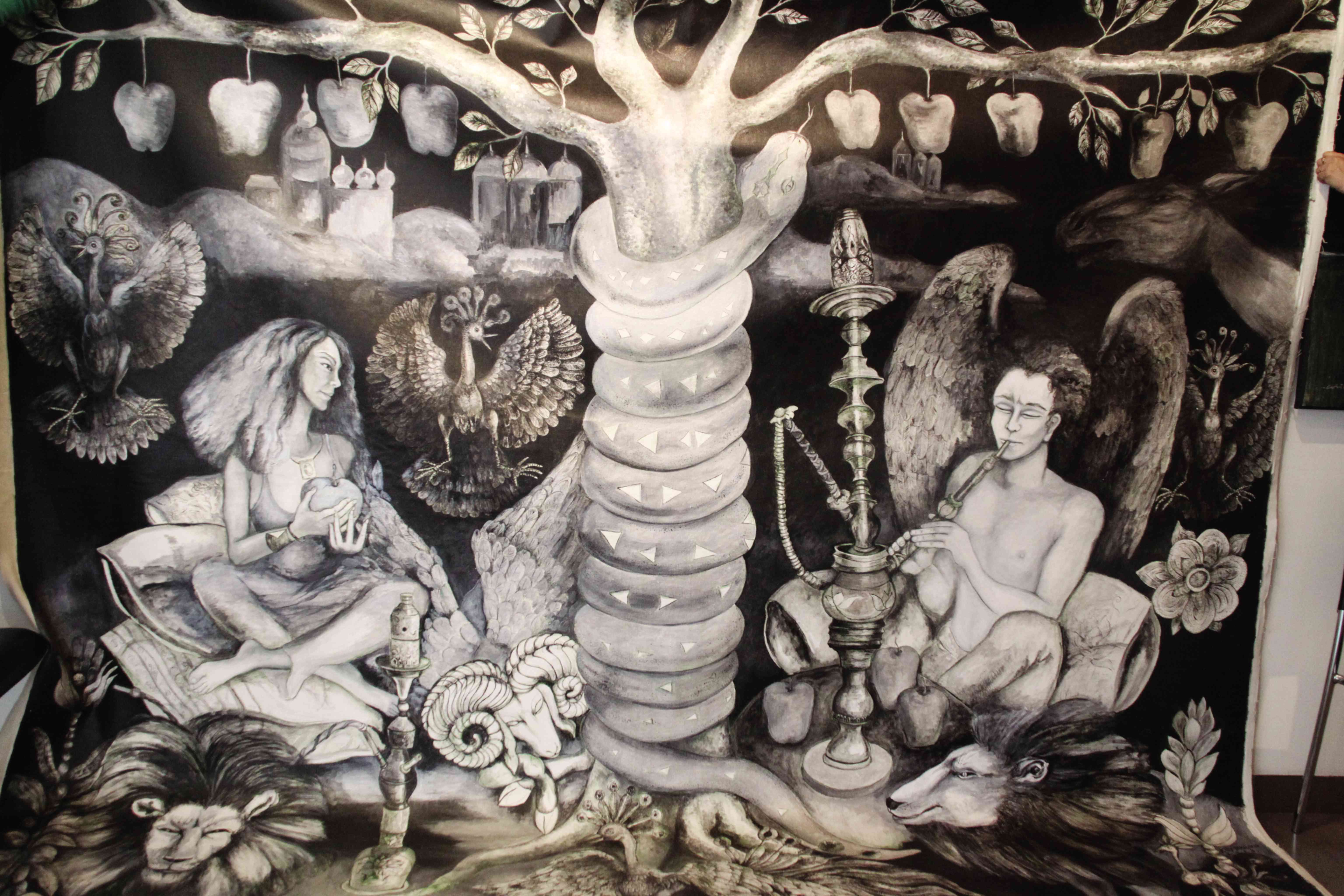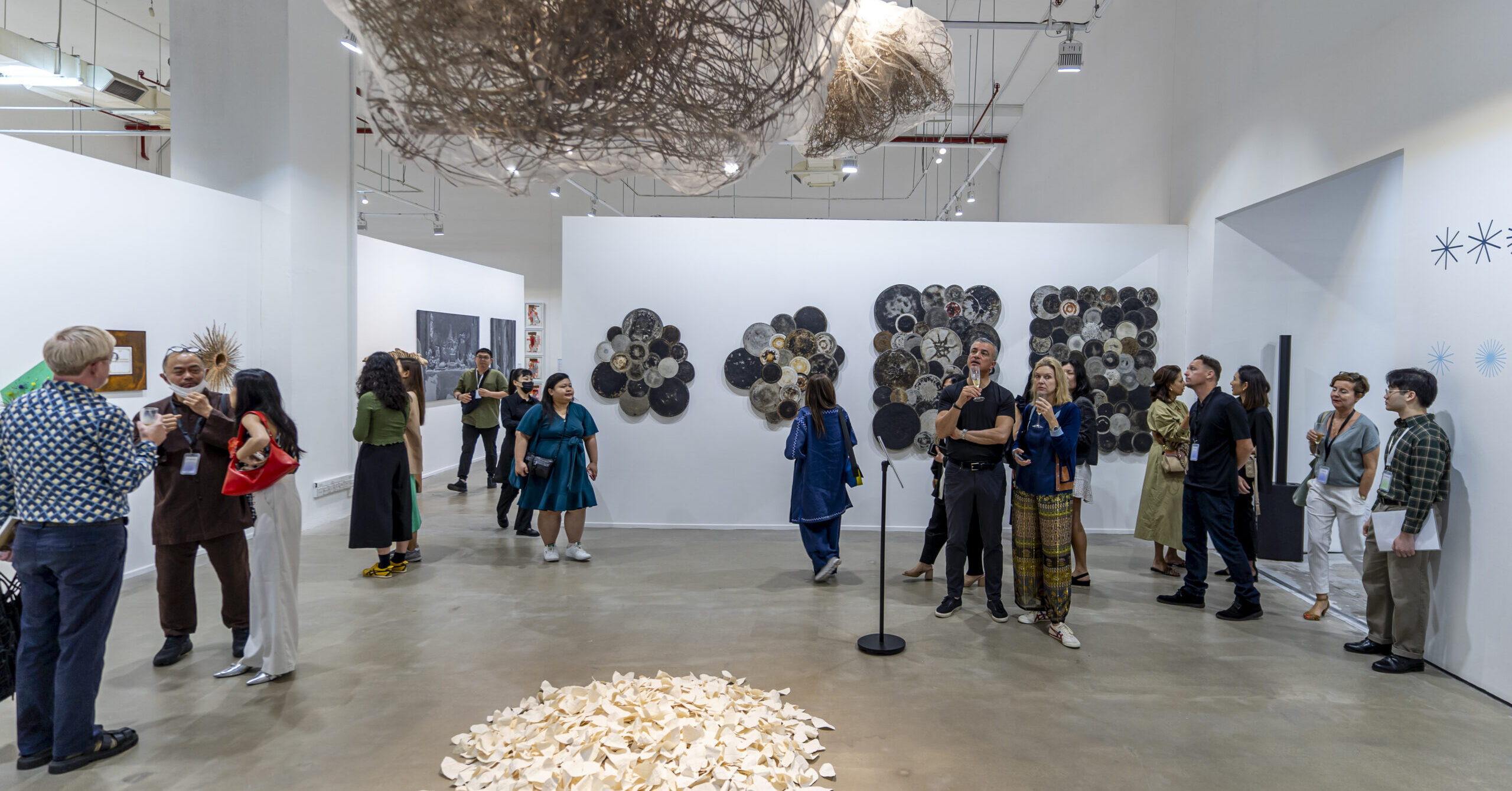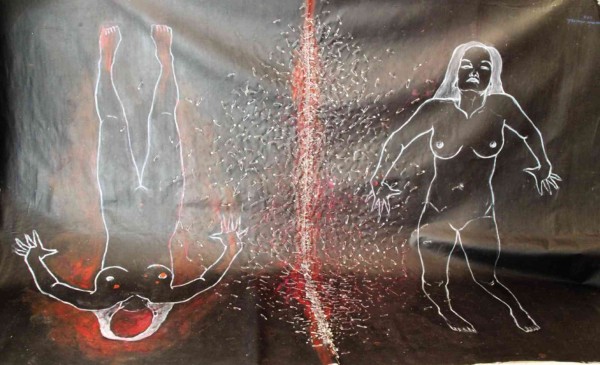
The rose has but a Summer reign.
The daisy never dies.—James Montgomery
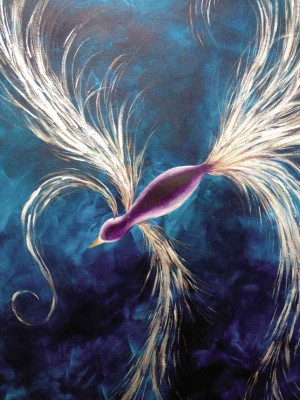
The verb “regurgitate”—meaning “to throw or pour back or out from a cavity”— may seem indecorously inappropriate when paired with the charming name of a flower, the daisy. It is this seemingly inelegant confluence of two words that ignites the show “Regurgitating Daisies,” now on view at Galerie Anna, SM Megamall.
Curated by Amiel Gerald A. Roldan, the exhibit is a guaranteed show-stopper, not just by the scale of the works (many measuring 6 ft x 8 ft), but by the power and expressiveness of the various themes that, yes, obsessed six top woman painters in the country. (Even the qualifying of gender may provoke some heated opposition.) But rest assured they know the themes and concerns of womanhood intimately. The curator has skillfully orchestrated a symphonic chorus of womanly woes and joys, deliriums and delights. This is a thoroughly, delightfully impressive show.
Almonte, De la Rosa
When a rare type of cancer struck the artist Yasmin Almonte, she mightily rallied with true grit. Despite her illness, her commitment to her art was unwavering. Well-known for her powerful erotic images, the artist is feminist to the core. Not surprisingly, her current works are shadowed heavily by the illness which she has had to confront.
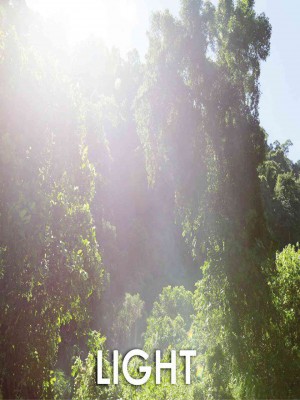
“I’m Still Standing” is her proud visual stance. On the left, woman is upturned, indeed as if descending headlong into a cauldron of fire, while on the right, she has summoned the strength to rise and stand up once again. What is horrific is the line that bisects the two images. Like a deep slash of wound, sutured by a stun of safety pins that possibly symbolize the errant cells that have invaded the artist’s frail body, it is a frankly unembarrassed painting.
The other work, “Forgiven,” is a catharsis of acceptance, with the emotional pull of an experience that has rendered one asunder. Writes the artist: “I am grateful that I can paint without shedding a tear.”
Temptation comes, as every human knows and experiences, in many guises. In the unrelieved attraction of the material world that flesh is heir to, humanity seems like a willing victim. Camille de la Rosa’s own “Temptation” is a deceptively bucolic image. The work alludes to classical painting, in particular the landscape works of the French masters Corot and Manet, with his pastoral “Luncheon on the Grass.”
De la Rosa, however, infuses her work with biting satire, luxuriant with Pop inflections, literally tempting with allusions to the New York metropolitan skyline while a Big Mac burger is irreverently, but with chic panache, nestled on the head of a woman picnicking on grassy ground. Indeed, she is even cradling a pig, squealing as though in a portrait of a “Mother and Child.” Her actual child, however, is a cute darling of a cherub, impish with earphones plugged into his ear, and fat sausages curled round his chubby arm, while licking on a cupcake. He is kept company by a bulldog, imperial with a crown on its head.
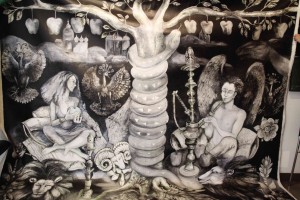
“Temptation” lures the viewer into the painterly delights of deceiving appearances, and of course, the pleasures of a well-crafted painting.
Mallari
Patti Mallari unleashes her avian creature, spinning out in space, in the aptly titled “Soaring.” The classic symbol for liberation and freedom, the bird is the epitome of gracious release and flight, recognized universally by artists from Braque to Brancusi. Even our National Artist Vicente Manansala devoted a series titled “Whir,” a multitude of overlapping wings rendered in his so-called “Transparent Cubism” style. Of course, National Artist Lucio D. San Pedro stirred our patriotic heartstrings with his emotionally impelling lyrics and melody: “Ibon Man May Layang Lumipad.”
Mallari’s “Soaring” is an oscillation of movement in space where the bird of magnificent plumage swirls within a magnetic force that contagiously spins in a fast-motion activity. The viewer himself is projected mentally within this centrifugal motion. Buoyant with briskly applied brushstrokes, “Soaring” verifies a sense of exultation in unimpeded space.
Cristina Taniguchi
A vision of Paradise emerges before the viewer’s eyes, but lest he expects a romanticized fairy tale, he would be well-advised to look elsewhere. Cristina Taniguchi casts a cold, calculating eye on the mythical and/or Biblical parentage of us all. Humanity has never had to confront a more thorny issue, nor have we been regaled with a cool Adam and Eve ensconced within the bliss of Eden.
In “The Egotist and the Lady,” the fabled garden is lorded over by a rising, tumescent tree trunk, where a slimy, slippery serpent coils around and upwards to take a lascivious lick at the suspended apples. Our Adam is in his own nirvana, zonked out into indifference with his lips hooked onto a hookah, puffing and inhaling the smoke of ecstasy. Our Eve cradles an apple as though imagining it were an infant nascent in her waiting womb.
In “Paraiso,” Eve, sans her wandering Adam, is very much the lady of the house, if not of her garden. In her triple states of undress, she roams the Mesopotamian grounds, in the company of mythical beasts. The unicorn’s single horn in the middle of the forehead is itself a nod to the days when innocence had yet to be lost, while the Tree of the Knowledge of Good and Evil counts the days, and the overhanging apples, when the end of Paradise is nigh.
Tang, Varona
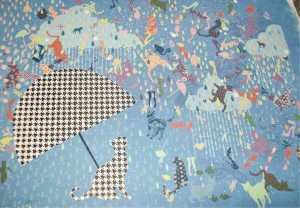
“Happiness in Randomness” is a painting that panoramically, exceedingly rains with happiness. In this large-scale work, Janelle Tang instigates a downpour of symbolical images that are themselves metaphorical allusion to the bliss of womanhood. In punctiliously clean and sharply defined rendition, the artist beguiles the viewer with images of femininity: cats in various poses, dangling high-heeled shoes, hearts and herons, knock-kneed legs, and unicorns.
Contrasting with the delightful pastel shades of the downpour is the black-and-white silhouette cutout of an umbrella, under which the same-patterned cat seeks shelter.
One senses the artist’s joy in creation, in the minutiae of art making, and the flaunting of graphic skills that have deservedly found an ideal subject. The painting is a sweet valentine to the delight of being a daughter of Eve. Janelle Tang has a gift for the visual embellishments of a bemusing narrative.
“Growing up with a camera is not alien to me. My father and his whole side of the family are into photography… Thank you, photography, you have given me even more artistic wings to fly with.” Thus remarked Anna Varona whose photography on canvas, with its title “Light” inscribed on the surface, is an effulgence of emotion. The admirable thing is that Varona captures an indescribable feeling without the intrusion of a human presence. The emotion is set off by a virtual landscape of trees with their crowded masses of leaves, so tightly compressed as to suggest an Impressionist painting dappled with shadows. From the blue skies descend an irradiation of opalescent light. Indeed, the viewer might hear a choir of angels, elsewhere within the tangled tufts of leaves.
To define light by its technical description is to miss the point of the artwork. The viewer will hardly respond to “an electromagnetic radiation in the wavelength range including infrared, visible, ultraviolet and X-rays, and traveling in a vacuum with a speed of about 186,281 miles per second.”
Where photography luxuriates is in the spiritual emanation of light, and its mystifying power to communicate with speechless language.

